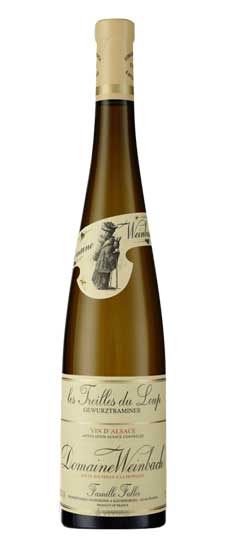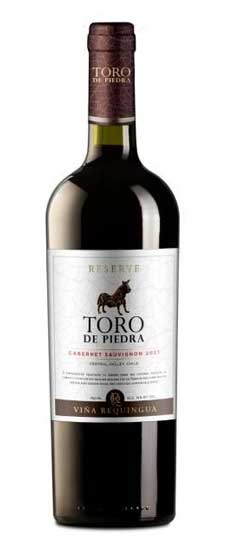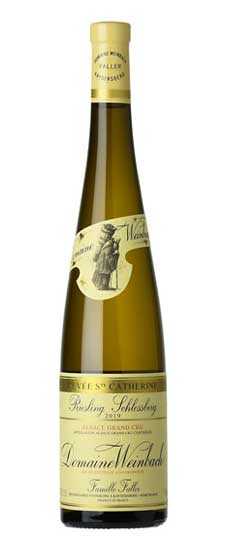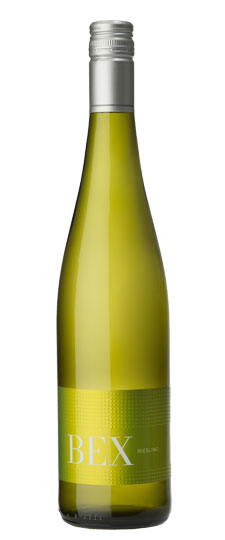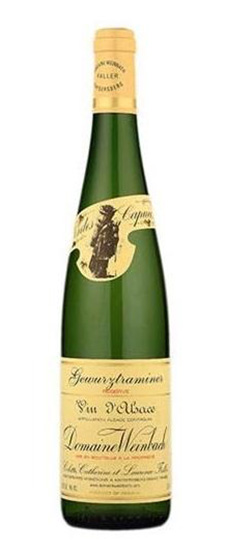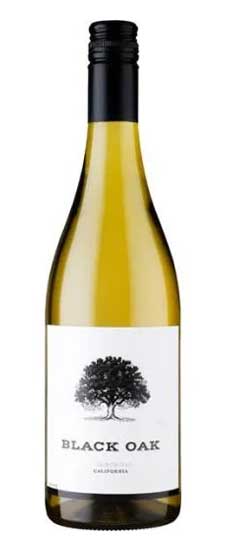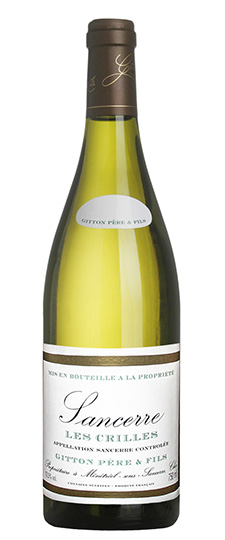Wine Score
98 points James Suckling
Enveloping, sensual bouquet of a thousand yellow fruits and some wild berries that’s just beginning to reveal its profundity. Gigantic concentration, but this remains as light on its feet as a prima ballerina. The gentle creaminess on the palate perfectly balances the mineral acidity that seems to blink like a star low in the sky. Enormously long and subtle finish. From biodynamically grown grapes with Demeter certification. Drinkable now, but better from 2023.
Grape Variety
Riesling Wine
Riesling is a light-skinned, aromatic grape of German origin which is – if the majority of top wine critics are to be believed – the world’s finest white wine grape variety.
For many, the claim above may seem at odds with the sea of chaptalized, low-quality wine exported from Germany in the late 20th Century. In truth, very little of that infamous wine was Riesling at all, but instead higher-yielding grapes such as Müller-Thurgau and Silvaner), but the reputation has nonetheless stuck. Riesling has also been stereotyped as just a sweet grape, used only to make sticky wines. But while botrytized Rieslings are among the finest sweet wines in the world, the majority of global Riesling wines are either dry or off-dry.
Riesling vines above the Mosel
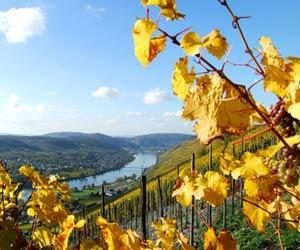 The Riesling vine holds a very different place in the wine world to such great grapes as Cabernet Sauvignon, Merlot or Chardonnay. While these immensely popular varieties have conquered every corner of the winegrowing world, Riesling is conspicuously absent from the core wine regions of France, Spain and Italy. Its fanbase is smaller, but fervent.
The Riesling vine holds a very different place in the wine world to such great grapes as Cabernet Sauvignon, Merlot or Chardonnay. While these immensely popular varieties have conquered every corner of the winegrowing world, Riesling is conspicuously absent from the core wine regions of France, Spain and Italy. Its fanbase is smaller, but fervent.
Riesling’s spiritual home is unquestionably the regions that trace the middle Rhine and the lower Mosel, two of Europe’s great wine rivers. Here we find the key wine regions of Germany, most famously Mosel, Rheinhessen, Rheingau and Pfalz. Riesling vines cover the steep, slate-rich hillsides above these famous rivers, and are used to make crisp, refreshing wines with pronounced acidity.
On the other side of the Rhine lies Alsace, once German but now part of France. Here, Riesling is the most important wine grape variety in terms of both quantity and (arguably) quality. Alsace Riesling has its own individual style, richer and more generous than those made in Germany. This is made possible by the region’s sunny, dry mesoclimate and the shelter provided by the Vosges Mountains.
Austria also produces a large quantity of Riesling, most notably from its eastern Wachau and Kremstal regions. This is made mostly in drier styles, although Lake Neusiedl, just southeast of Vienna, creates a sufficiently humid climate for the production of sweet botrytized Riesling.
Happily, Riesling has found several New World niches to which it is very well suited. The high quality Rieslings now made in Australia’s Clare and Eden valleys have proved this with particular competence. Most notably, Clare Valley Riesling has emerged as a style in its own right, with crisp, citrus-scented acidity and aromas of toast and honeysuckle. Just across the Tasman Sea, New Zealand is also making high-quality Riesling in Canterbury and Otago, while South Africa’s Riesling is also showing promise. The famous ice wines of Canada are made mostly from Riesling or Vidal, and have further demonstrated the cold-resistant characteristics of this hard-wooded variety.
There are various clones and sub-varieties of Riesling in existence, and the variety has multiple variations on its name (e.g. Johannisberg Riesling, Rhine Riesling). To complicate matters, there are several white grape varieties that bear the name Riesling, but are entirely unrelated. The most notable of these are Welschriesling (Riesling Italico), Okanagan Riesling and Cape Riesling, which itself is also known as Crouchen, Paarl Riesling and Clare Riesling.
A rare, pink-skinned variant of Riesling – Roter Riesling – is grown in Germany and Austria. There is ongoing debate as to whether Roter Riesling is a mutated form of traditional Riesling, or vice-versa.
Synonyms include: Weisser Riesling, Johannisberg Riesling, Johannisberger, Rhine Riesling, Riesling Renano.
Food matches for Riesling include:
- Quiche Lorraine; zwiebelkuchen onion cakes (dry)
- Thai green curry (off-dry)
- Key lime pie (sweet)
Region
Schlossberg Wine
Schlossberg is an Alsace Grand Cru vineyard located on the slopes above Kaysersberg and Kientzheim in Alsace, north-eastern France. At 197 acres (80ha), it is the largest of the region’s 51 Grand Cru sites and the oldest; it was the first Alsace vineyard to be granted Grand Cru status when classification began in 1975.
Schlossberg is amongst the best known of all Alsace vineyard names. It acquired its title from the castle (schloss in German) at its western edge, which it has stood guard over Kayserberg and the Weisbach Valley for 800 years. The vineyards are much older than the castle though; Roman colonists tended vines here more than 1500 years ago.
Schlossberg
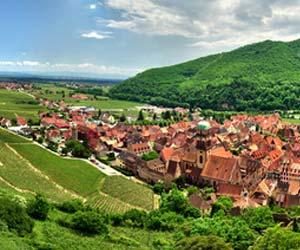 Schlossberg Grand Cru, overlooking Kaysersberg
Schlossberg Grand Cru, overlooking Kaysersberg
This site is one of a quartet of Grand Crus located on the northern slopes of the Weisbach Valley (Furstentum, Mambourg and Marckrain are the other three). They are significant because of the degree to which their south-facing slopes extend out onto the plains north of Colmar. The majority of Alsace’s Grand Cru sites closely hug the lower slopes of the Vosges, away from the over-fertile soils of the plains. As a result, they are generally restricted either to the occasional south-east-facing slopes, or to the south-facing slopes on finger-like promontories. The unbroken south-facing slope which runs west–east for three miles (4.8km) from Kayserberg to Bennwihr is therefore something of an exception. Schlossberg is located at the western edge.
The slopes here rise steeply from 800 to 1400ft (245–425m), making them some of the steepest and highest in the region – surpassed only by the dramatic Rangen hillside. They have a south and south-easterly aspect, with the vines exposed to the ripening rays of the sun throughout the morning and into the afternoon. Schlossberg is divided between two non-contiguous sections, separated by a folded rift in the hillside but sharing the same soil type and aspect. The smaller, northern section is one-tenth the size of the main slope directly above the town of Kayserberg.
The Schlossberg hillside is composed largely of granite, with the upper layers in an advanced state of decomposition. As a result, the topsoils contain a high proportion of coarse granitic sand, rich in potassium, magnesium and phosphorus – minerals that are found in few other vineyards. The distinctive style of Schlossberg Riesling wine is attributed largely to this unusual soil composition.
The climate of the area is of continental type with particularly low rainfall – a result of the rain shadow cast by the Vosges. The mountains also provide protection from the prevailing westerly winds, making the Alsatian summer one of the driest and warmest in the northern half of France. At the other end of the temperature scale, the winters here are cold; it is not uncommon to see Alsace vineyards lined with snow.
Apart from a few notable exceptions, all Alsace Grand Cru wines are varietals and may be made from Riesling, Gewurztraminer, Pinot Gris or Muscat. Schlossberg has each of these varieties planted and is particularly well known for its Riesling.
Schlossberg is entirely separate from the smaller Wineck-Schlossberg, two miles (3km) to the south.
Producer Notes
About Domaine Weinbach
Domaine Weinbach is a leading wine estate in the Alsace region. It is named after the “wine brook”, a small stream that runs through the main property, which is a former monastery near Kayserberg. The estate is known for its wines made at varying levels of sweetness from Riesling, Pinot Gris, Pinot Blanc, Sylvaner, Gewürztraminer and Muscat.
Domaine Weinbach
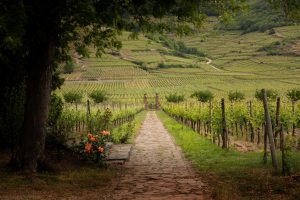 Unusually for the region, Weinbach only uses estate-grown grapes. It has holdings in four nearby Grand Cru vineyards on the slopes of the Weisbach Valley – Schlossberg, Furstentum, Mambourg and Marckgrain. Weinbach also owns the famous 5-hectare (12-acre) monopole, Le Clos des Capucins, which surrounds the cellars just below Schlossberg, and the Altenbourg vineyard adjacent to Furstentum.
Unusually for the region, Weinbach only uses estate-grown grapes. It has holdings in four nearby Grand Cru vineyards on the slopes of the Weisbach Valley – Schlossberg, Furstentum, Mambourg and Marckgrain. Weinbach also owns the famous 5-hectare (12-acre) monopole, Le Clos des Capucins, which surrounds the cellars just below Schlossberg, and the Altenbourg vineyard adjacent to Furstentum.
All of the estate’s 28ha (69 acres) of vineyards have been farmed biodynamically since 2005 and are certified by Ecocert and Demeter. After a gentle, gradual pressing, the juice is slowly fermented in old oak vats using indigenous yeasts.
For several decades the estate was run by Colette Faller and her daughters, winemaker Laurence and sales director Catherine. Laurence died tragically young from a heart attack in 2014, and her mother passed away the following year. Catherine Faller now runs the estate with her sons.

